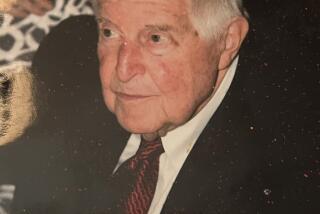Robert S. Chandler dies at 74; National Park Service veteran
Robert S. Chandler, who dealt with complex problems as superintendent of many of the country’s largest national parks and took the lead in implementing the Santa Monica Mountains National Recreation Area in the late 1970s and early ‘80s, has died. He was 74.
Chandler, a resident of Tehachapi, Calif., died Dec. 23 of multiple myeloma at a hospital in Bakersfield, said his son, Alan Chandler.
In a 38-year career with the National Park Service that began in 1958 and included serving as superintendent of the Grand Canyon, Olympic and Everglades national parks, Chandler was known as an effective leader who worked with local communities and state and government officials on tough issues.
“There was nobody better,” said John Reynolds, who worked with Chandler as assistant superintendent of the Santa Monica Mountains National Recreation Area.
“He was a person who multiple national park service directors sent to places that needed calm and inclusive leadership,” Reynolds said. “He was always sent to the most complicated, sensitive spots.”
As the first superintendent of the Santa Monica Mountains National Recreation Area after Congress authorized its inclusion in the national park system in 1978, Chandler was faced with several challenges.
They included going through a formal process to establish a boundary for the recreation area, which extends west from Griffith Park to Point Mugu.
“Our contract was to create a partnership with the state, the county, the city and private landowners to create this cooperative partnership,” Reynolds said. “Because this was an unprecedented arrangement, it was highly complex.
“There was a potential for great controversy, and it needed a leader who was willing to work with other partners as opposed to trying to take them over. And it worked; it still works.”
Chandler also led successful efforts to acquire several large parcels within the recreation area that were under imminent threat of being developed, Reynolds said.
In 1981, James G. Watt, the newly appointed secretary of the Interior, imposed a freeze on National Park Service land acquisition funds and stated publicly: “I do not believe the national park system should run urban parks.”
Chandler reportedly received a verbal reprimand for publicly defending the recreation area and criticizing Watts’ action.
“What Bob said on national TV was he thought Watts’ ideas were shortsighted,” Reynolds said. “He never received a formal reprimand, but he was in hot water.
“But the fact of the matter is the people of the Los Angeles area and their political representatives at all levels said this park needs to exist and continue to grow.”
Woody Smeck, the current superintendent of the Santa Monica Mountains National Recreation Area, said Chandler “had a clarity of vision for how national parks should be managed and had the ability to bring diverse parties together to forge a common vision and purpose.
“In the case of the Santa Monica Mountains, that skill set was so critical. He came in really with nothing on the ground and built the framework for what is now the nation’s largest urban national park.”
Chandler faced other challenges in his career.
As superintendent of Olympic National Park in Washington state for six years in the 1980s, he reportedly helped defend the park from encroaching loggers, dealt with mountain goats eating native plants and helped stop tourists from pilfering marine life on the park’s coastline.
And when he completed two years as superintendent of Everglades National Park in Florida to become superintendent of Grand Canyon National Park in 1991, he received the praise of National Park Service Director James Ridenour.
“In the Everglades, he has grappled with some of the most difficult environmental issues faced by any park, culminating in the recent settlement of a complex lawsuit to assure the protection of the water needs that wetland system depends on for survival,” Ridenour told the Miami Herald.
Chandler’s career also included heading the Park Service’s Chicago office at a time when Great Lakes area parks were being added to the national park system and serving as superintendent of the Jefferson National Expansion Memorial in St. Louis.
As a park management specialist, Chandler traveled to Germany, Russia, Poland, Canada, Brazil and Central America to assist in the development of parks.
His final assignment before retiring in 1996 was as general manager of the Presidio of San Francisco, where he led its conversion from Army post to national park.
Born April 19, 1936, in Washington, D.C., Chandler received a bachelor’s degree in horticulture from the University of Maryland in 1958, the same year he joined the National Park Service as a horticulturist with the National Capital Parks.
After retiring, he served on the secretary of the Interior’s Advisory Board on National Parks and helped write its seminal report “Rethinking the National Parks for the 21st Century.”
In addition to his son Alan, Chandler is survived by his wife of 53 years, Mitzi; his other children, Donna and Richard; his brother, Glenn; and three grandchildren.
A memorial service is pending.
More to Read
Start your day right
Sign up for Essential California for the L.A. Times biggest news, features and recommendations in your inbox six days a week.
You may occasionally receive promotional content from the Los Angeles Times.






